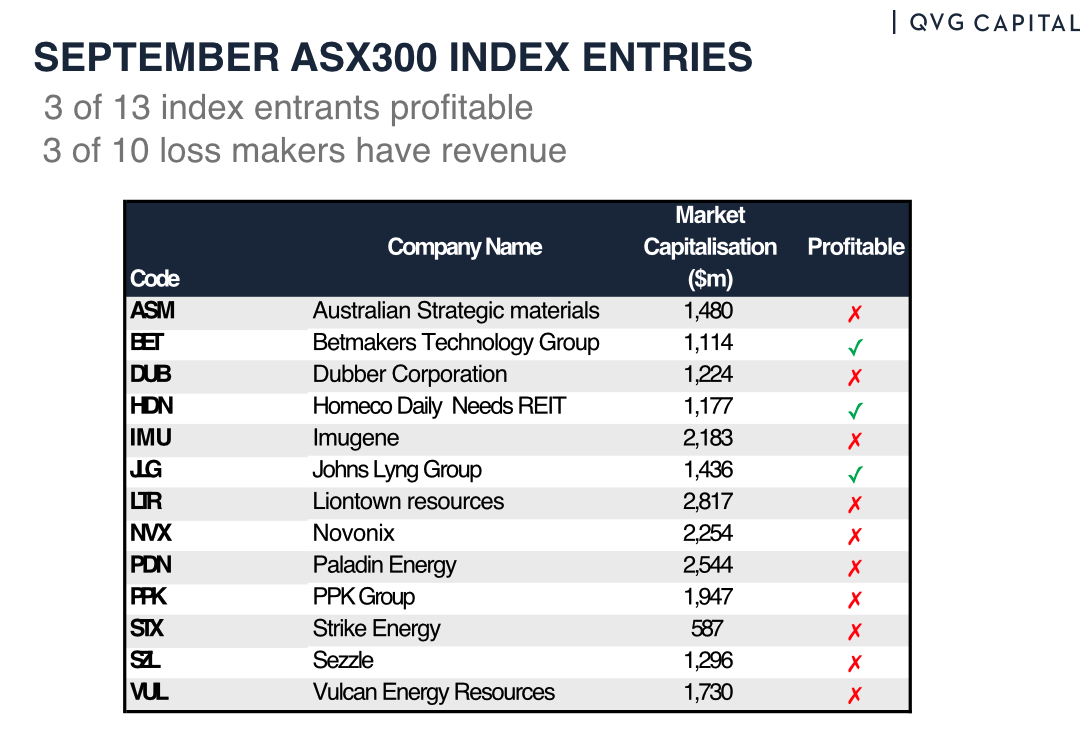No cash? No worries! The ASX300 is flush with shorting candidates
QVG Capital presented a webinar last week which included a segment from our Long Short Portfolio Manager Josh Clark. One slide in Josh’s presentation elicited more questions and interest than any of the others.

(Source: QVG Capital)
The table above shows the 13 stocks that have recently been promoted into the S&P/ASX 300 index. Every 6 months - in March and September - the dark cabal that is S&P’s index committee get together and ‘promote’ and ‘delete’ stocks from various indices. The index committee don’t make exactly clear what criteria they use to make their decisions and retain the rights to use their discretion, but we know entry and exits are largely dependent on the stock’s market capitalisation rank versus peers and its trading volumes.
To dumb it down; stocks going up and getting more liquid get promoted and those going down and less liquid can get cut.
Why the ASX300 is a big deal
The S&P/ASX 300 index is an important index. The 300 is the benchmark that index funds such as the $18B Vanguard Australian Shares Index (VAS) seek to replicate. It’s also the pool that many quantitative and institutional managers tend to use as a cut off for their potential investable universe. In other words, entering the S&P/ASX 300 is a sign companies have ‘made it’ and it's time to put on their big-boy pants.
As stocks approach a likely entry they tend to outperform and vice versa for those exiting the 300.
Index entry affords a company a wider shareholder base and lower costs of capital; this is a big deal for companies that need capital to grow.
The most interesting thing about the most recent set of 300 entries is the lack of quality. Just 3 companies going in to the 300 are profitable (and we were a little generous on Betmakers because we looked forward to FY22 consensus earnings). Of the 10 remaining entries just 3 have meaningful revenue.
- Dubber is forecast to do $45m of revenue in FY22 putting it on a lazy 27x revenue.
- Novonix is forecast to generate $12.6m of revenue with a calculator breaking revenue multiple of >170x.
- Sezzle has forecast revenue of $164m; albeit with a -$70m forecast bottom line loss.
Speaking of losses there are plenty of them in in this ASX300 entry cohort.
Take occasional Uranium producer Paladin Energy for example. Over the past 10 years it generated positive operating cash flow in only 3 of those years and free cash flow only once. That hasn’t stopped it going up 500% over the 12 months though!
Battery minerals are flavour of the month with Australian Strategic Minerals, Liontown, Novonix and Vulcan tied to the theme. The other thing they have in common is the significant need for capital and cash flows that are many years away.
With $8B of combined market capitalisation, more capital required to get into production and positive free cash flow unlikely until FY25 in aggregate this cohort looks like a bad bet.
At QVG we aren’t heretics. We believe a company is worth the sum of its future cash flows discounted back at an appropriate rate. This hasn’t stopped us from owning cash-burning companies like Afterpay, Xero or Tyro but when we do this we place a heavy emphasis on the certainty of revenue, the unit economics of the business (a fancy way of saying ‘how they make money’) and qualitative factors such as management quality and long-term competitive advantage. These factors are harder to assess when a company is pre-revenue or dependent on an unknowable future commodity price.
So what is the practical application of all this?
We suggest the following:
- Be aware there are technical factors such as index inclusions that can drive share prices well above fair value.
- Don’t get caught up in thematic mania (or if you can’t help yourself keep your bets small). Whether it’s Pot stocks two years ago or Iron Ore two months ago speculative mania’s do not last.
- If you buy an index product, be aware you’re buying the good, the bad and the ugly.
And finally, if it’s all too hard find a handsome and daring fund manager who can get you long cash earners and short cash burners (like Josh).
Chris Prunty is a Founder of, and Portfolio Manager at QVG Capital. QVG Capital runs the QVG Long Short Fund.
9 stocks mentioned

